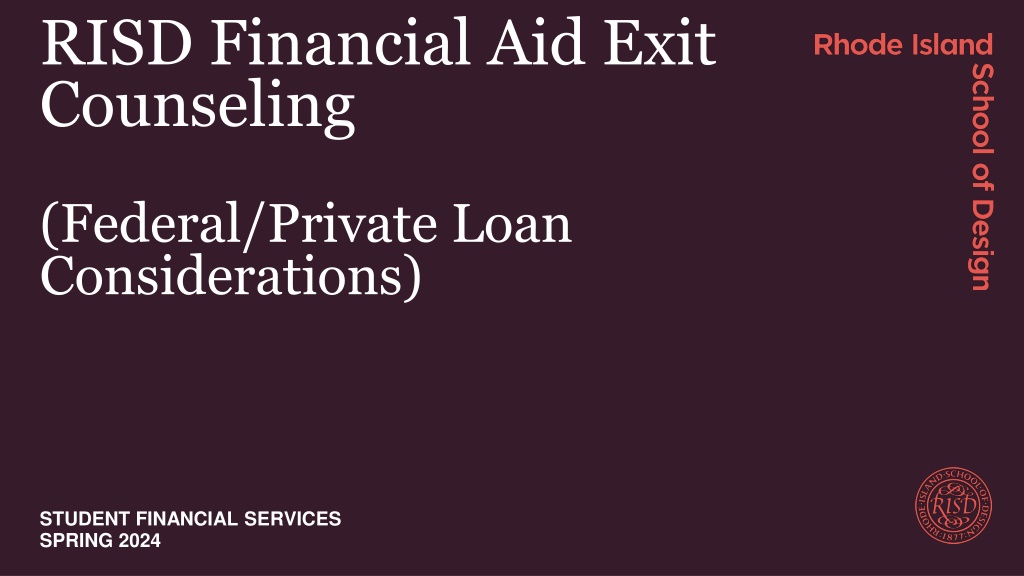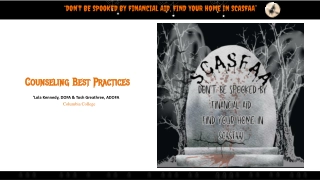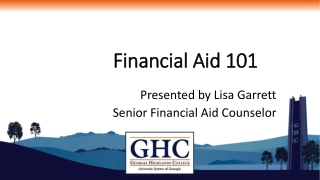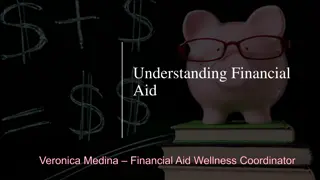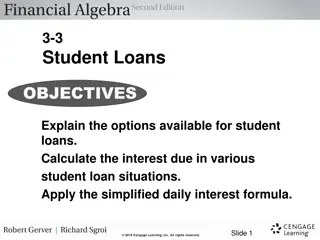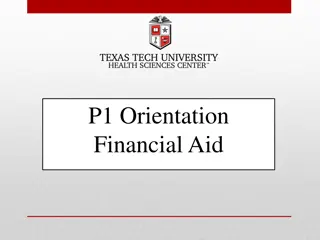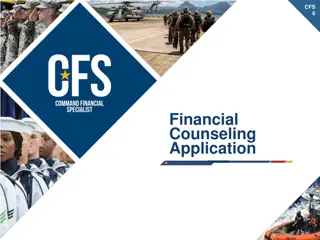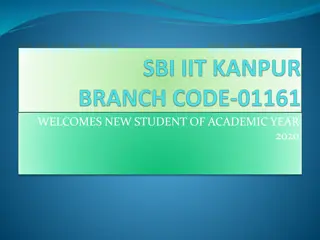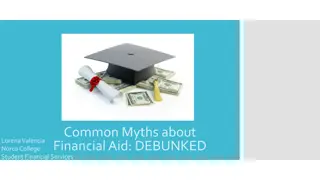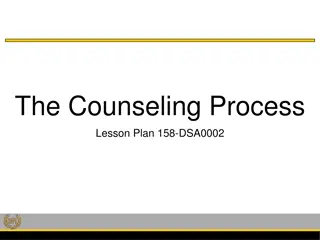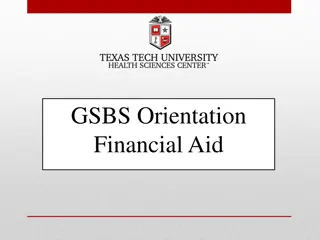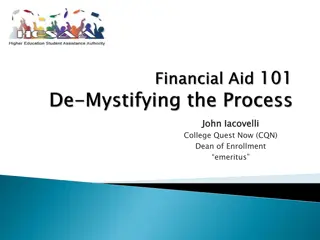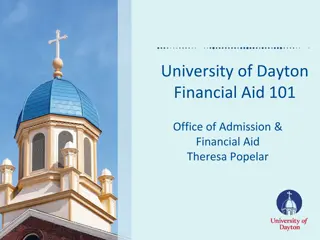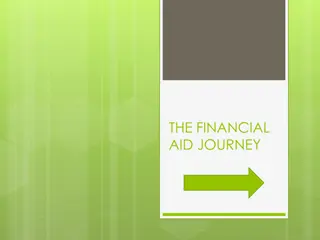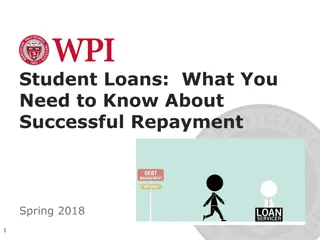Understanding RISD Financial Aid Exit Counseling for Federal and Private Loans
Federal Loan Exit Counseling is mandatory for all students who have borrowed federal loans, with deadlines to meet. Private loan exit counseling requirements vary by lender. Prepare for repayment according to the best practice timeline provided, knowing your rights and responsibilities as a borrower. Stay informed about repayment options, deferment, forbearance, and loan cancellation/discharge. Make sure to fulfill your obligations as outlined in the Master Promissory Note. Additional information and resources are available through the provided links.
Download Presentation

Please find below an Image/Link to download the presentation.
The content on the website is provided AS IS for your information and personal use only. It may not be sold, licensed, or shared on other websites without obtaining consent from the author. Download presentation by click this link. If you encounter any issues during the download, it is possible that the publisher has removed the file from their server.
E N D
Presentation Transcript
RISD Financial Aid Exit Counseling (Federal/Private Loan Considerations) STUDENT FINANCIAL SERVICES SPRING 2024
Requirement! Federal Loan Exit Counseling: Online program required for all students who borrowed federal loans Complete Student Loan Exit Counseling Complete by 6/1 Private Loan Exit Counseling Each individual lender will have their own requirements. Reach out to them, if you haven t already, and ensure that you are fully aware of their repayment requirements. Complete by 6/1 2
Best Practice Timeline July 2024 Prepare for repayment! November likely first payment due 6 month grace period after end of classes 5/17/2024 3
Rights Prior to your repayment, the loan holder is required to provide you with a disclosure statement containing a repayment schedule and information regarding interest rates, fees, balance owed and repayment options. You have the right to a grace period. (Federal Direct Student Loan). If you qualify, you have the right to defer payments on your loan(s) after the grace period expires (only applies to certain situations) and you have the right to request a forbearance. You may prepay the entire sum of your student loan or pay more than the minimum requirement at any time without penalty. You have the right to cancellation/discharge if the borrower dies, becomes permanently and totally disabled, is unable to complete a program of study because the school closed, is a victim of forgery, or if a loan is falsely certified by the school. The U.S. Department of Education may transfer servicing of your loans. If this occurs, you will receive notification from the current servicer and from the new servicer. http://studentaid.ed.gov/repay-loans/understand/servicers Under the Direct Loan Program, you can change repayment plans anytime. 4
Responsibilities The federal Master Promissory Note (MPN) that you signed was your promise to repay the funds. It provides important language about your rights and responsibilities with respect to obtaining and repaying the loan. Repay the loan(s) according to the repayment schedule (even if you have not received a bill). Notify the servicer of any circumstance that affects your ability to repay, or to confirm your eligibility for deferment or forbearance. Notify the servicer if you have graduated, withdrawn from school, dropped below half-time status, transferred to another institution, and/or changed your name, address, phone number or social security number, or if you fail to enroll for the period covered by the loan(s). Complete an exit counseling session before leaving school. Repay at least $600 per year ($50 a month, unless you have a deferment, Income Driven Repayment plan, or your lender agrees to a lesser amount). Remember that your loan(s) must be repaid even if you do not complete your education, are unable to obtain employment upon completion, or are dissatisfied with the educational program. 5
Federal Loan Exit Counseling https://studentaid.gov/h/manage-loans https://studentaid.gov/h/manage-loans Takes about 30 minutes Requires your FSA ID https://studentaid.gov/fsa-id/sign-in/landing Federal website has greatly improved with useful information You do not finalize your repayment option during this session 6
Tips for Exit Counseling Website: 1. Use PC over Mac 2. Don't use Safari; use Chrome 3. Clear cache and cookies 4. Use an incognito window 5. If there is an invalid graduation date, consider using a current date and pay attention to the format requested. 7
Your Federal Loans at RISD Parent PLUS/Grad Paid to parent or Grad student Unsubsidized: Interest accrues while in school and deferment Direct to student loans: Federal Direct Student Loan (2 types) Subsidized: Interest paid by government Unsubsidized: Interest accrues while in school and deferment Fixed interest rate set each year Year Interest Rate % Fixed Interest rate set each year Year Interest Rate % Origination Fee % Origination Fee % 2019/2010 7.595 4.2 2018/2019 5.045 1.01 2019/2020 7.079 4.2 2018/2019 4.529 1.01 2020/2021 5.3 4.2 2020/2021 2.750 1.01 2021/2022 6.28 4.2 2020/2021 3.73 1.01 2022/2023 7.54 4.2 2021/2022 4.99 1.01 2023/2024 8.05 4.2 2022/2023 5.50 1.01 Graduate Rate 7.05% 8
How To Find Your Current Loan Information Your Loan Servicer: The 9 companies to which the Department of Education has awarded contracts to service your loans. Examples: - MOHELA - Nelnet - Great Lakes - ECSI - EdFinancial - Aidvantage (former Navient) National Student Loan Data System Federal website that contains full accounting of your loan information (review once a year) https://studentaid.gov 9
Federal Loan Repayment Variety of options No prepayment penalties Ability to change plans (be careful switching out of income driven repayment; defaults to 10 year plan) Standard: 10 Years Extended: 25 Years ($30,000 or more in total fed loan borrowing) Graduated: Payments start low, and increase over time Examples: Gross Amount of Debt $50,000 $75,000 $100,000 $150,000 Standard (10 year plan) $555 $832 $1,110 $1,665 Extended (25 year plan) $322 $483 $644 $965 Payments that exceed 15% of income are generally considered excessively burdensome and may not be sustainable 10
Sample Budget: From Recent Financial Planning Session 11
Federal Income Driven Repayment Powerful tool to help make student loan payments affordable. Income sensitive Payments based on AGI, not how much you owe Low required monthly payments (new plan guards against negative amortization) Multiple plans, but typical graduates currently utilizing SAVE: - payment amount is calculated as 5% of the adjusted gross income (AGI) that exceeds 225% of the poverty level - Possible forgiveness as soon as 10 years - Auto Enrollment after Missed Payments https://studentaid.gov/announcements-events/save-plan 12
Default Excessive delinquency* on student loan payments. Default if you fail to make your monthly payment for a total of at least 270 days. Very Serious - - - - - entire unpaid balance becomes due high collection fees wages garnished/loss of professional license lien on property lose eligibility for additional student aid and federal benefits Very Avoidable! - Stay in contact with your servicer, deferment, forbearance options. https://studentaid.gov/manage-loans/default *Delinquency starts after 1 day of late payments; after 30 days = late payment reported to at least one credit bureau. 13
Federal Loan Safety Nets Deferment: required payment pause - - - In-school (unsubsidized loans continue to accrue interest) Economic Hardship Military Service Forbearance: Payment pause - - - Up to 3 years total (no more than 12 months at a time) Requires application Life event Future of these options hard to predict. https://studentaid.gov/manage-loans/lower-payments/get-temporary- relief/forbearance 14
Loan Forgiveness Public Service Loan Forgiveness. Federal loan forgiveness after 10 years of repayment under qualifying employment and 120 payments (does not need to be consecutive) Three Requirements: Qualifying Repayment Plan Right kind of employment Remaining Loan Debt https://studentaid.gov/manage-loans/forgiveness-cancellation/public-service PSLF Help Tool: https://studentaid.gov/pslf/ 15
Loan Forgivness as a benefit? Employer Loan Forgiveness Programs: https://www.wsj.com/articles/companies-pay-down-workers-student-debt- as-supreme-court-weighs-forgiveness-f3ce6be4 16
Loan Consolidation Combining federal loans into one new loan, with a weighted average interest rate. Pros: Simple way to manage loans Bring loans together if under $30,000 to take advantage of extended repayment Interest rate becomes weighted average of all loans consolidated; minimal change to interest rates. Cons: Interest rate slightly higher (consolidated loan 1/8 % higher rate) New loan! If consolidating during your grace period, repayment begins immediately. Lose benefits from individual loans https://studentaid.gov/app/launchConsolidation.action 17
Refinancing Convert variable rate loans (if you have them) to a fixed rate loan Potentially lock in a lower interest rate (example, higher rate Grad PLUS loan to lower rate private loan) Simplify the borrower s life one bill/one payment per month Receive an interest rate reduction for automatic monthly payments Provide for additional borrower benefits Comparing Refinance Options Interest rate Fixed or variable? Based on credit? Fees What are they? Up front, back end or both? How much will they add to total cost? Repayment How long is the term? What is the monthly payment? APR Is the total cost of borrowing including accruing interest, capitalized interest and fees - expressed as an annual interest rate? A tool which can be used to compare the total cost of one loan to another. What borrower benefits are offered by the lender? What must be done to achieve them? Does the loan have different repayment options? Does the loan have an Income-Based Repayment option? Is deferment or forbearance available? If the student who benefitted from the loan dies or is permanently disabled, is the loan forgiven? 18
Final Tips Closely review your monthly budget before deciding on a repayment plan Set Up Electronic Payment Set it and forget it .25% reduction interest rate https://www.nerdwallet.com/article/loans/student-loans/auto-pay- student-loans Give yourself some grace 68% of graduates from nonprofit colleges had loans in 2016* Very few students default * Student Loan Hero, student debt statistics 19
You Are Not Alone! We remain a resource for you! Feel free to continue to contact us as an alum. https://www.risd.edu/sfs 20 Washington Place, First Floor 401-454-6661 sfs@risd.edu Office hours: Monday-Friday, 8:30 am-4:30 pm 20
FederalOmbudsman Having an issue with your loan servicer? Other loan related issues? You may contact the Federal Student Aid Ombudsman Office. They are a resource to help you resolve issues that you cannot resolve through your loan servicer. Phone: 1-877-557-2575 https://studentaid.gov/feedback-ombudsman/disputes/prepare 21
Resources and Links Federal Loans Federal Loan Website: https://studentaid.gov/understand-aid/types/loans The Institute of Student Loan Advisors https://freestudentloanadvice.org/ Financial Planning Foundation for Financial Planning (probonoplannermatch.org) Additional Sessions this summer as needed! 22
